|
As a high school graduation gift, my dad and I traveled to Peru for two weeks. We spent the first week in the south traveling around Cusco, the Sacred Valley and Machu Picchu. Very nice, but I'm sure you all have already heard enough about that area. If you want to see photos, I have a Flickr set of the trip to southern Peru. The only thing I have to say is when visiting Machu Picchu, don't spend the night at Aguas Caliente. It would have been possible to take the train from Ollantaytambo to Machu Picchu, climb Huayna Picchu, explore the ruins and hike to the Inca bridge and be back in Ollantaytambo or Cusco all in the same day. We didn't plan the second week, so after reading the guidebooks and talking with tourists in the area, we decided to head north and visit Chiclayo and Chachapoyas. We're both history and archeology fans, so we mostly focused on visiting ruins. Day 1 Visited the Sican, Bruning and Tombs of Sipan museums. Sican and Bruning weren't very interesting, but the Sipan museum was amazing. The entire museum is devoted to the excavation of a single tomb, object by object. It was more like an art museum than anything. Also visited the site of Tucume, a massive complex of adobe pyramids and platforms. A thousand years of erosion have melted the bricks, but the structures are still recognizable.  About a third of the Tucume buildings, as seen from the only natural hill for miles. All of the mounds in the picture are the remains of pyramids. 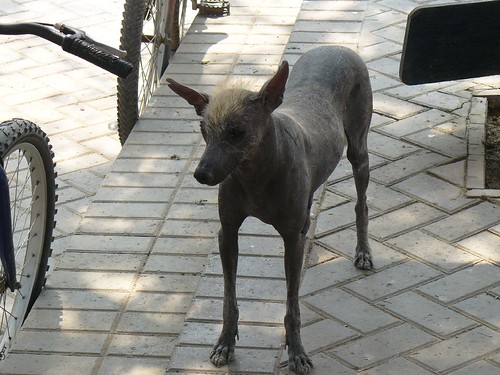 A Viringo, an ancient breed of (mostly) hairless dog that was in steep decline a few years back. Several of the museums in the area keep these dogs on site. Day 2 I got hit by a bad case of Atahualpa's revenge. It was a hell of a lot worse than I thought it would be, due to the really bad dizziness and headache in addition to the classical symptom. I decided to stay in the hotel room and rest for the bus ride later that day while my dad explored the city. He says the witch market with various potions and animal parts for sale is an interesting visit. At 7:30 we got on the overnight bus to Chachapoyas. Day 3 We arrived around 4am, checked in to our hotel and went to sleep. We woke up around 8 to try to visit some sites, but were informed that the road out of town closes down every morning at 6 for construction. We made arrangements for the next two days, then caught a cab to Levanto, a pleasant nearby village. The cab dropped us off at Yelape, a very overgrown set of ruins. We poked around for a while then walked to Levanto. After hanging around in the plaza for a bit, we walked back to Chachapoyas on a pre-Inca stone trail. The trail has seen heavy use ever since its construction and was pretty eroded. Fantastic views along the way, a 3 hour downhill walk to the road then uphill on a paved highway back to Chachas. My dad sprained his ankle, so we caught a pickup back to town once we hit the road.  Levanto's Plaza  Horses tied up near the trail Day 4 We went to Kuelap, the main attraction in the region and what drew us here in the first place. It's a three hour trip each way from Chachapoyas, and we went with two other tourists and a guide around 5:30am. We stopped briefly to view Macro, a cliffside city before slowly ascending a scary but beautiful road to Kuelap. It's a fortress city built on top of a 50 foot tall platform designed to look like part of a natural ridge. We took the standard route around the fortress, then up a set of stairs onto the platform. The fortress is about half a kilometer long, so we spent plenty of time wandering around and looking at the buildings, carvings and interior walls. After the fortress, we had a late lunch in a village on the way back before returning to Chachapoyas around sunset. 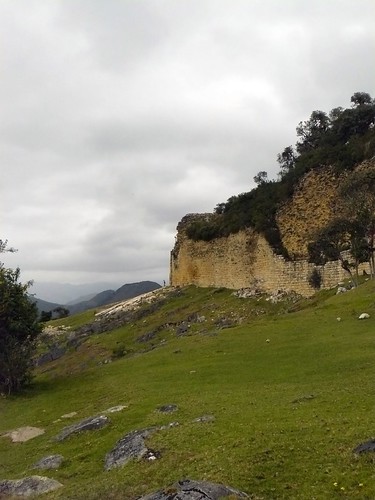 The wall surrounding the fortress  Details on an interior wall 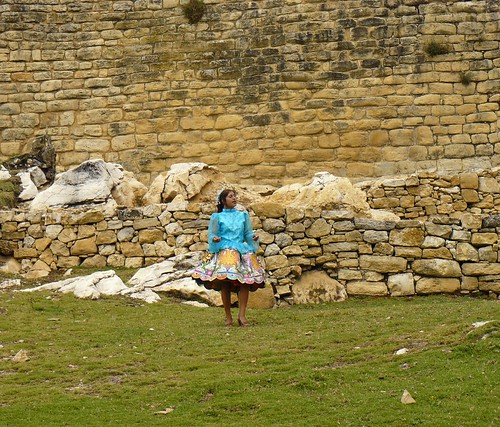 Someone was filming a commercial at the ruins Day 5 Another very early morning to beat the construction. After a two hour drive and a half hour walk, we arrived at Karajia, a set of painted cliffside tombs shaped to look like famous warriors and crowned with the skulls of their enemies. Looters have long since removed gold and artifacts, and the archaeologists got the mummies. Very 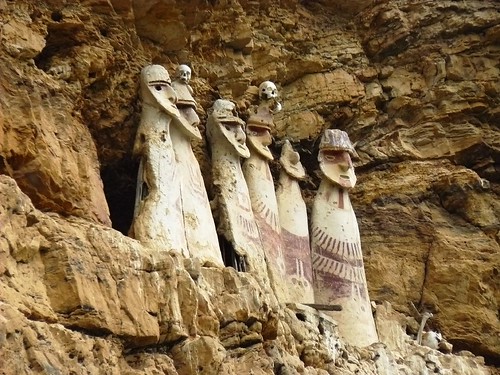 There was still plenty of time, so we visited Pueblo de los Muertos, another set of cliff tombs. These were a short but difficult (one of the other tourists with us this day broke her ankle) hike down a hill then across a narrow ledge built to support the tombs. The tombs and the way the Chachapoyan culture built them into the cliffs were amazing, as were the carvings in the walls and the human bones still scattered around the site.  Looking back at the tombs 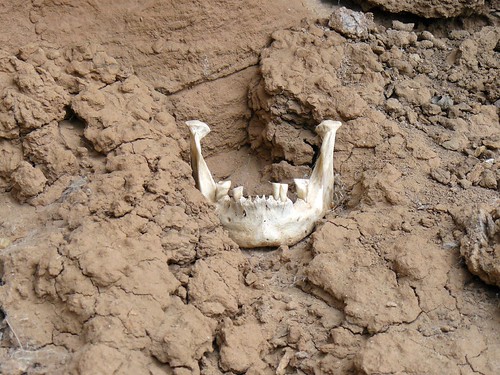 A jawbone sitting on the cliff The tourist who broke her ankle said it was only a minor sprain that didn't hurt badly, so we decided to head to one more tomb site, whose name I can't remember. It's near the towns of Lamud and Luya and down a road currently torn up for sewer construction, but that's all I can remember. Bring a tripod and a good set of binoculars (I left my tripod in the truck  ) because these are only visible across a valley unless you've brought rappelling gear. ) because these are only visible across a valley unless you've brought rappelling gear.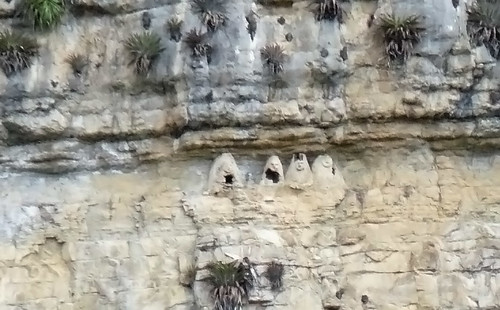 Four of the twenty or so sarcophagi visible in the valley. And with that, our trip to Peru was over, except for a twelve hour ride back to Chiclayo then a flight to Lima. The rest of the photos from the north are in another Flickr set. The only problem we had was the difficulty of visiting ruins independently. Kuelap would have been possible by taking a series of minibuses, but Karajia would have been very difficult. Pueblo de los Muertos is locked to prevent looting, and a key obtainable from the local cultural office is th only way in. For those two days, we ended up going with a group for about $20 per person including transportation, guide, tickets and food. Food and hotels are a lot cheaper than in the south for the same levels of quality. Private and public transportation is cheap but dangerous and slow. If you're planning a trip to Peru or Ecuador, I highly recommend visiting the Chachapoyas area and the rest of northern Peru. We didn't have time to visit Cajamarca in the mountains or Trujillo on the coast, but heard very good things from all the backpackers we met. There are ruins and ancient cities much larger and more spectacular than Kuelap in the jungles and mountains to the west of Chachapoyas. If you have the time, it's possible to hike in and spend a day to several weeks exploring them. A bit south of we were and easily reachable by bus are Revash and Leymebamba. Revash is another cliffside tomb complex, similar to Pueblo de los Muertos but larger and in better shape. There's a museum in Leymebamba with a few hundred mummies found in the region, as well as the artifacts looters missed. Gocta waterfall is another sight, either the third or the fourteenth highest in the world and surrounded by caves that still have mummies lying in them. It was visible way off in the distance from Pueblo de los Muertos and would make an interesting day trip.
|
|
|
|

|
| # ¿ May 2, 2024 10:07 |
|
CatchrNdRy posted:These pictures are great, thanks for sharing. What would you say the Peruvian locals were like? I keep hearing how aloof they are as compared to most of South America. It was the first time I had been in South America, so I wouldn't be able to compare them to other South Americans. My dad has traveled around around the continent some, and spent 3 years working in Central America back in the 80s. He didn't have any complaints about the locals. The Spanish was a lot more formal than what I had been speaking during my Spanish classes at school. This was a big plus for me, and I had no difficulty understanding anyone during the whole of the trip. I live in Seattle, and the people in Peru remind me of the people up here. We're kind of formal and shy with strangers, but will quickly warm up in conversation. Of course, talking to kids of my own age was lively and informal pretty much from the start of a conversation.
|
|
|
|
Why not, pictures from Southern Peru: Terraces at the ruins in Pisac just as the sun was setting. 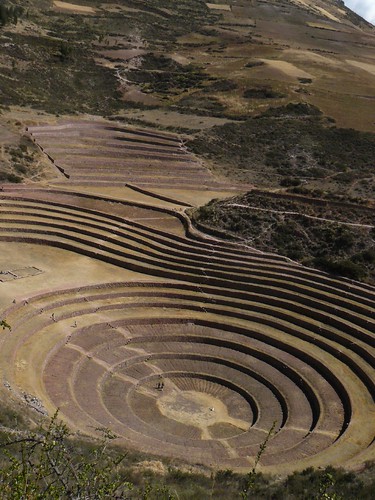 Moray, thought to be an Incan scientific center. Because of all the different seeds found and the very different microclimates at the site, it was thought to be a place where the Incas bred different varieties of crop to grow throughout the empire. 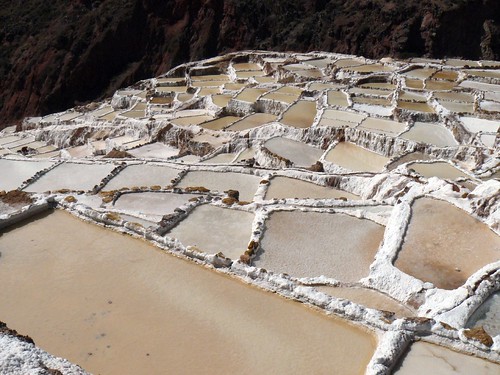 Salineras, a working salt mine that lets tourists in to look around. A tiny spring feeds water to the pools via a very complex system of boards and channels. The insanely salty water evaporates in the pools to be collected by hand.  Looking over to the Ollantaytambo ruins while hiking. 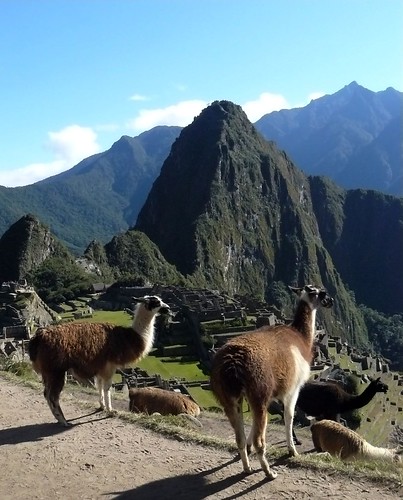 Machu Picchu was really expensive to visit, but definitely worth it. The national cultural agency keeps a herd of llamas on site to add to the atmosphere. 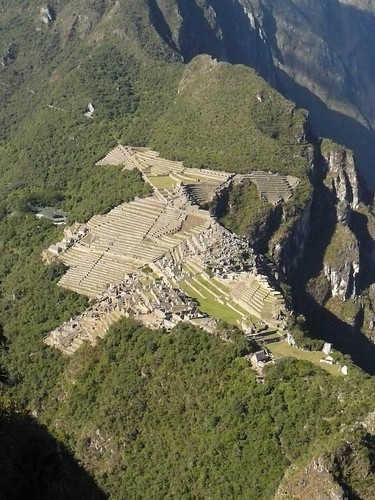 The view from on top of Huayna Picchu, the peak in the background of all Machu Picchu photos. The hike up is an interesting but thigh destroying trek up a set of stairs the entire way, but the view is incredible. If you're going to do it, arrive very very early to Machu Picchu and head directly to the hike entrance, because they only let 200 people up at a time.  Stonework on some buildings in Cusco. 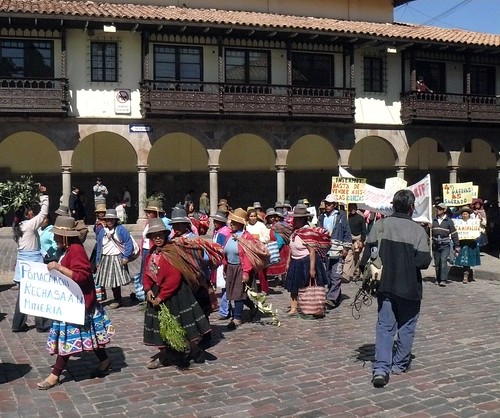 While taking pictures of the architecture in Cusco's main square, about a thousand farmers and their families marched in and began circling. From theirs signs and from speaking with them, they were protesting a lack of government regulation to gold mines going up in the area where they lived.  Cusco's cathedral
|
|
|




